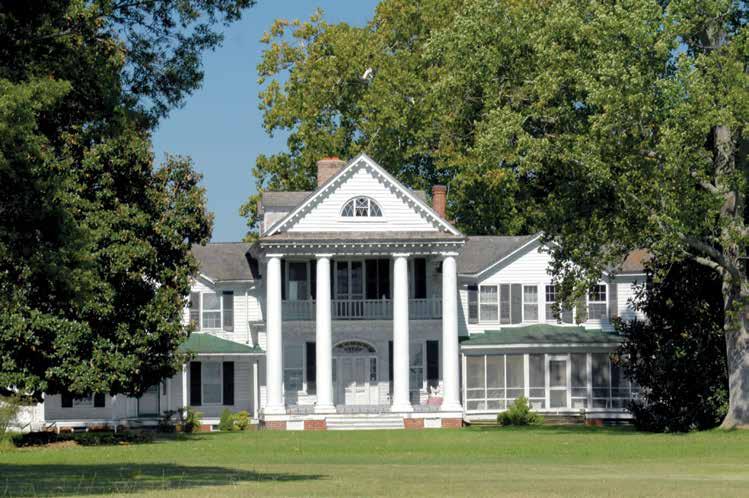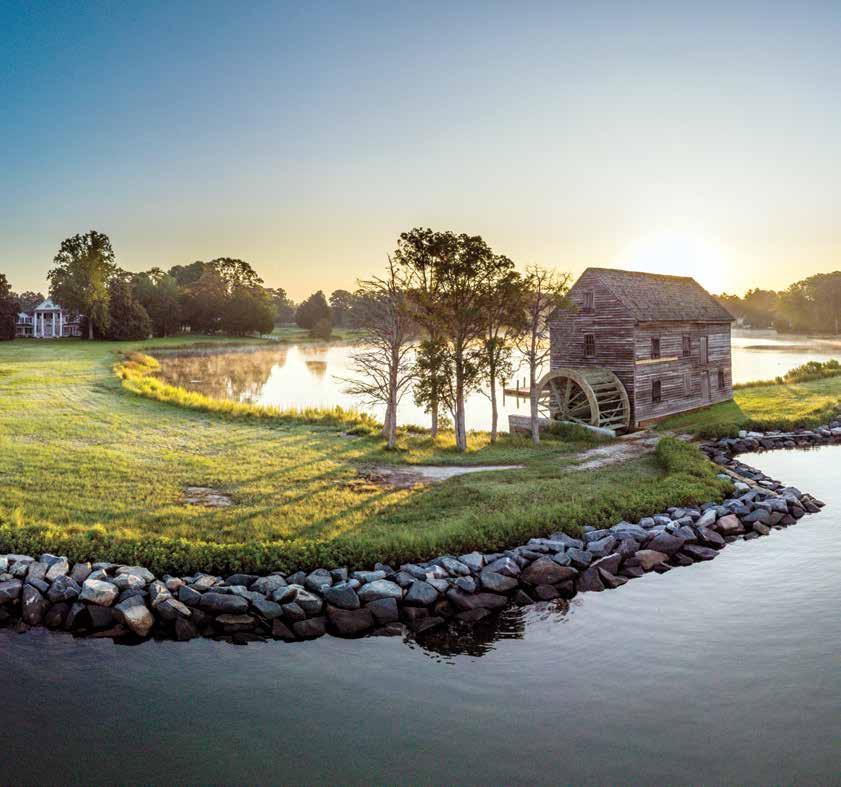
9 minute read
Poplar Grove and its Tide Mill
Poplar Grove
TIDE MILL By Bob Cerullo AND ITS
Advertisement
The famed genius, Albert Einstein, once commented, “The true sign of intelligence is not knowledge but imagination.” In this age of incredible invention, it is easy to pay little attention to those inventions that changed the world. Yet, they are the basic building blocks for the modern marvels we enjoy today. Consider the water wheel. There were water wheels in ancient Mesopotamia, Egypt and Europe during different time periods. It is not known who the genius was that first invented
the water wheel. There is some evidence the water wheel may have been used as early as 3500 BC. The water wheel grew to become one of mankind’s most important inventions.
Then came the tide mill. A tide mill is a water mill driven by tidal rise and fall. Historians believe it was in Ireland that an Irish monk developed the tide mill. It was located on an island that did not have any freshwater streams, so the resourceful Irish monks turned to the latent power of the twice-daily rise and fall of the tides, which washed the shore at the bottom of the monastery.

(right above) Poplar Grove Mansion, circa 1935. Courtesy of Francis B. Johnston. (right below) Original building of Poplar Grove Mansion. Courtesy of Francis B. Johnston


The concept of a water wheel turned by the incoming and outgoing tide came to America with the arrival of immigrants. The immigrants were mostly from the south of England and had a great deal of experience because they built many tide mills along the English Channel,
especially in Devon and Cornwall. The earliest tide mill to be built in North America was in 1607 at Port Royal in Canada. In later years, tide mills
appeared in the northern areas of colonial America. The Dutch settlements in New Amsterdam, later named New York, used tide mills. New England used tide mills from early colonial times and as late as the twentieth century. Boston is known as the early tide mill center.
Incredibly, after more than 200 years of blasting winds, driving rains, snow, hurricanes, tornados and being razed by fire during the Civil War, a tide mill at Poplar Grove in Port Haywood, Vir ginia still stands. It was burned during the Civil War, as were most mills at that time. The mill was rebuilt after the Civil War and operated until 1912. The original tide mill was built during colonial times on land which was part of an original grant from King George III to Samuel Williams and his son, Thomas. Local legend has it the Poplar Grove tide mill ground grain for George Washington’s troops during the Battle of Yorktown. While possible, the story is, however, unsubstantiated. The mill is in remarkably good condition for its age. In its time, it bustled with the work of the tide miller and several slaves who worked the mill, some times until late hours of the night, depending on the tide.
The massive tide mill gearing is still there, and the wooden water wheel has recently been replaced. To build the tide mill, slaves had to build a dam across a narrow finger of land that stretched eastward of the wide river in front of the Poplar Grove plantation. This lagoon created a sort of reservoir or pond which stored the incoming tide water that allowed it to be channeled through a sluice (water channel) to the water wheel. The miller could, by controlling the wooden sluice gates, gain power to turn the wheel from the flow of both the incoming tide and the outgoing tide. The wheel would continue to turn until either the water behind the dam fell below the level of the sluice, or more frequently, until the water level in front of the dam rose above the sluice at high tide.
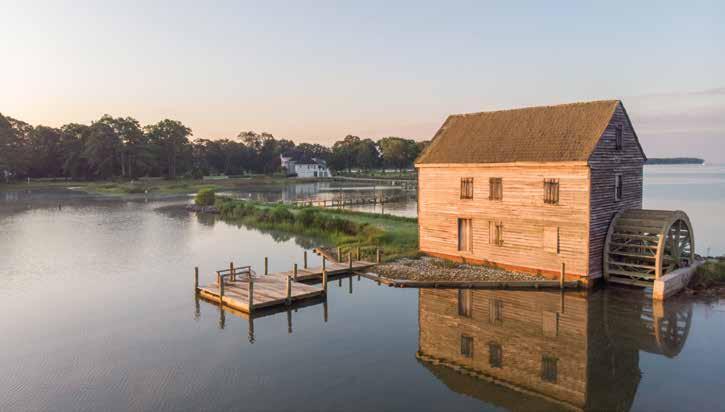
Pump house located to the rear of the mansion. Courtesy of Bob Cerullo
Photo courtesy of Terry Young. www.airaspects.com

Courtesy of Bob Cerullo

Courtesy of Bob Cerullo
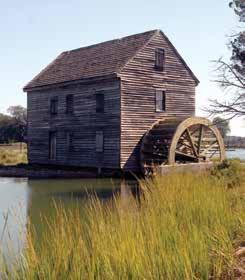
Tide mills offered the unique advantage of a water supply that was entirely dependable. They were typically free from the risks of drought or upstream diversions. Tide mills had the obvious advantage of not depending on the strength or direction of the wind on a given day. Indeed, too-strong winds were a hazard to the sails of windmills.
Tide mills were often cheaper to locate and build than water mills because no dam was needed. Tide mills had the major disadvantage that the tides, while predictable, occurred at different times of the day. Tide millers worked according to a tidal calendar chiefly determined by the moon. The tide miller would need to split his full-night’s sleep into nap periods during the twice-daily incoming tides. The Poplar Grove tide mill could produce 32 bushels of meal with each tide. Its unique sluice gates made it possible to capture the incoming and the outgoing tides, making it possible to operate the mill four times a day.
Across the lagoon from the mill stands the mansion, the first part of which is believed to have been built for the Williams family in the late eighteenth century. The earliest portion of the house is a small, one-and-a-half story, gambrel-roof cot tage, which has been incorporated into the present five-section house as an end wing. It is believed that the west wing of the house was built by Samuel Williams or his son, Thomas Williams, about 1782. A local legend reports that about ten years later Thomas lost the 1,000-acre property to his overseer, John Patterson, in a game of cards. Patterson came to America from England. He fought on the American side during the American Revolution. He was promoted to the rank of colonel by George Washington himself at the Battle of Monmouth.
At that time, feelings between the Whig and Tory parties were running high. The Lombardy poplar tree was the symbol of the Whig party. Patterson planted numerous trees on the lawn and called the plantation Poplar Grove, perhaps to show his support for the party. It was Patterson who built the main part of the house. The mansion became a social center for the area with Patterson and his daughters, Mrs. Thomas Robinson and Mrs. Christopher Tompkins, hosting many parties. Upon his death, the property descended to his daughter Maria Booth Patterson.
The home is known as the birthplace of Sally Tompkins, a famous Civil War nurse. Born at Poplar Grove on November 11,1833, she was the granddaughter of Colonel William Pat terson. Her father was Colonel Christopher Tompkins, a very successful planter, sea captain, ship owner and shipbuilder. (See The House and Home Magazine, March/April 2017, The Confed erate Angel, page 20.) Confederate President Jefferson Davis appointed Sally Tompkins to the rank of captain in the Confederate Army to facilitate her operation of a hospital for soldiers she established in Richmond, Virginia to care for the Civil War wounded.
The central portion of the house is a late-eighteenth century temple-form building fronted later by an ionic portico with its towering columns and lots of windows. The main stately Federal portion is believed to have been built for John Patterson sometime after 1799. Over the years, several additions have been added. The home has the design characteristic associated with a local builder named Richard Billups.
The beautiful main staircase is impressive. There are four staircases in the house, each unique to the style of house in

Newly restored water wheel at Tide Mill. Courtesy of Bob Cerullo
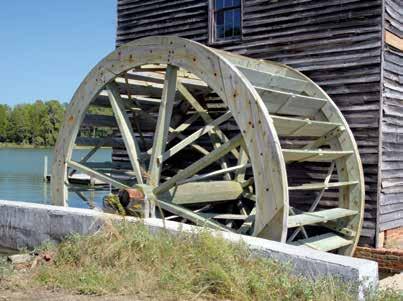
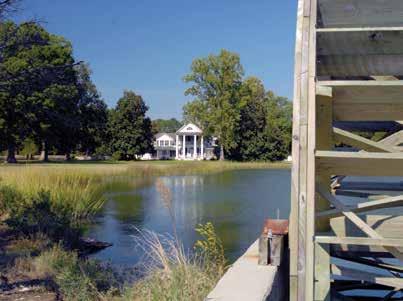
Mansion across the lagoon from the Tide Mill. Courtesy of Bob Cerullo
Gearing enables the wheels to turn in the same direction when the tide changes. Photo courtesy of Bob Cerullo


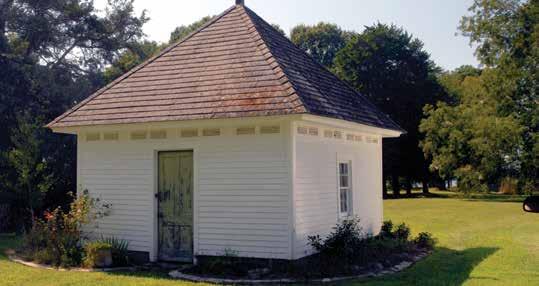
which it was built. The house is built on different levels with lovely paneling in the west wing, the oldest part of the mansion. The original kitchen was at some point separated from the main house and moved across the road to where it stands today. Over the years, it has been converted into a home. During the time of slavery, the kitchen slaves lived on the third floor of the main house. Further to the rear is a pump house, which was the main source of fresh water. There are some smaller storage buildings, including a smokehouse, a milk house and what is now a garage to the rear of the main house.
At one time Poplar Grove was the residence of Judge G. Taylor Garnett, who held court in the house. Mrs. George Upton, who bought the estate in 1927, extensively furnished it with antiques and reproductions.
There is a distinctive garden with serpentine walls very similar to those at the University of Virginia. The large grove is one of the most outstanding features of the estate. Behind the house is a building now used as a tool shed.
The house and mill are listed in the National Register of Historic Places and the Virginia Department of Historic Re sources. The Poplar Grove Plantation was for a brief time owned by musician John Lennon, of Beatles fame, and his partner Yoko Ono. After Lennon’s death, Ono donated the plantation to the New Beginnings Boy’s Therapeutic Foster Home, Inc. The 22.5-acre estate where the Polar Grove tide mill still stands is on the shore of East River in Mathews County, Virginia. The present owner, Bernadine Teague, purchased the plantation in 1985. Teague has a passion for the place and its history. Although she has gone to great expense to preserve it, Teague would one day like to see the Poplar Grove tide mill fully restored. She also has a great interest in Captain Sally Tompkins and has donated a great deal of money toward the erec tion of a statue of Tompkins known as the “Angel of the Lost Cause.” The statue is to be placed at Capitol Square in Richmond, Virginia.
The Poplar Grove tide mill and the mansion are a very important part of the history of the area. They combine both a living memory of the architecture of the time and the industry that was very much a vital part of everyday life in the South. H
